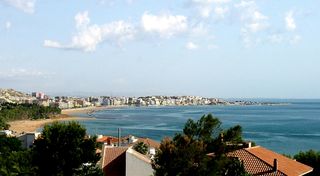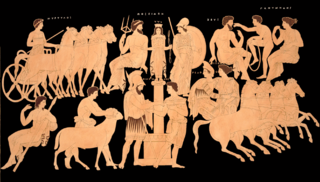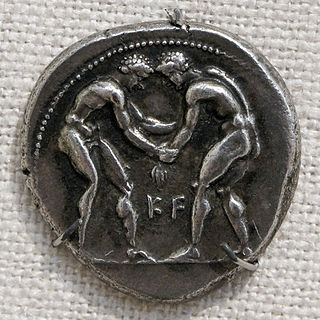
Pankration was an unarmed combat sport introduced into the Greek Olympic Games in 648 BC. The athletes used boxing and wrestling techniques but also others, such as kicking, holds, joint-locks, and chokes on the ground, making it similar to modern mixed martial arts. The term comes from the Greek παγκράτιον, meaning 'all of power', from πᾶν (pan) 'all' and κράτος (kratos) 'strength, might, power'.

Thurii, called also by some Latin writers Thūrium, and later in Roman times also Cōpia and Cōpiae, was an ancient Greek city situated on the Gulf of Taranto, near or on the site of the great renowned city of Sybaris, whose place it may be considered as having taken. The ruins of the city can be found in the Sybaris archaeological park near Sibari in the Province of Cosenza, Calabria, Italy.
Asopus is the name of four different rivers in Greece and one in Turkey. In Greek mythology, it was also the name of the gods of those rivers. Zeus carried off Aegina, Asopus' daughter, and Sisyphus, who had witnessed the act, told Asopus that he could reveal the identity of the person who had abducted Aegina, but in return Asopus would have to provide a perennial fountain of water at Corinth, Sisyphus' city. Accordingly, Asopus produced a fountain at Corinth, and pursued Zeus, but had to retreat for fear of Zeus' terrible thunderbolt.

Crotone is a city and comune in Calabria, Italy.

In Greek mythology, King Oenomaus of Pisa, was the father of Hippodamia and the son of Ares. His name Oinomaos denotes a wine man.

Sybaris was an important ancient Greek city situated on the coast of the Gulf of Taranto in modern Calabria, Italy.

Louis Cyr was a French Canadian strongman with a career spanning the late 19th and early 20th centuries. His recorded feats, including lifting 500 pounds (227 kg) with one finger and backlifting 4,337 pounds (1,967 kg), show Cyr to be, according to former International Federation of BodyBuilding and Fitness chairman Ben Weider as stated in 2000, the strongest man ever.

Pausanias was a Spartan regent and a general. In 479 BC, as a leader of the Hellenic League's combined land forces, he won a pivotal victory against the Achaemenid Empire in the Battle of Plataea. Despite his role in ending the Second Persian invasion of Greece, Pausanias subsequently fell under suspicion of conspiring with the Persian king Xerxes I. After an interval of repeated arrests and debates about his guilt, he was starved to death by his fellow Spartans in 477 BC. What is known of his life is largely according to Thucydides' History of the Peloponnesian War, Diodorus' Bibliotheca historica and a handful of other classical sources.

Aleksandr Aleksandrovich Karelin is a Russian politician and retired athlete.
In Greek mythology, the Dactyls or Daktyloi were the archaic mythical race of male beings associated with the Great Mother, whether as Cybele or Rhea. Their numbers vary, but often they were ten spirit-men so like the three Korybantes or the Cabeiri that they were often interchangeable. The Dactyls were both ancient smiths and healing magicians. In some myths, they are in Hephaestus' employ, and they taught metalworking, mathematics, and the alphabet to humans.

Strength athletics, also known as Strongman competitions, is a sport which tests competitors' strength in a variety of non-traditional ways. Some of the disciplines are similar to those in powerlifting and some powerlifters have also successfully competed in strongman competitions. However, strongman events also test physical endurance to a degree not found in powerlifting or other strength-based sports, such as carrying refrigerators, flipping truck tires, and pulling vehicles with a rope.

Metapontum or Metapontium was an important city of Magna Graecia, situated on the gulf of Tarentum, between the river Bradanus and the Casuentus. It was distant about 20 km from Heraclea and 40 from Tarentum. The ruins of Metapontum are located in the frazione of Metaponto, in the comune of Bernalda, in the Province of Matera, Basilicata region, Italy.

Greek wrestling, also known as Ancient Greek wrestling and Pále (πάλη), was the most popular organized sport in Ancient Greece. A point was scored when one player touched the ground with his back, hip or shoulder, or conceding defeat due to a submission-hold or was forced out of the wrestling-area. Three points had to be scored to win the match.

The Temple of Hera, or Heraion, is an ancient Archaic Greek temple at Olympia, Greece, that was dedicated to Hera, queen of the Greek gods. It was the oldest temple at Olympia and one of the most venerable in all Greece. It was originally a joint temple of Hera and Zeus, chief of the gods, until a separate temple was built for him. It is at the altar of this temple, which is oriented east-west, that the Olympic flame is lit and carried to all parts of the world. The torch of the Olympic flame is lit in its ruins to this day. The temple was built in approximately 590 BC, but was destroyed by an earthquake in the early 4th century CE.
Polydamas of Skotoussa, son of Nicias, was a Thessalian pankratiast, and victor in the 93rd Olympiad.

The ancient Olympic Games were a series of athletic competitions among representatives of city-states and were one of the Panhellenic Games of Ancient Greece. They were held at the Panhellenic religious sanctuary of Olympia, in honor of Zeus, and the Greeks gave them a mythological origin. The originating Olympic Games are traditionally dated to 776 BC. The games were held every four years, or Olympiad, which became a unit of time in historical chronologies. They continued to be celebrated when Greece came under Roman rule in the 2nd century BC. Their last recorded celebration was in AD 393, under the emperor Theodosius I, but archaeological evidence indicates that some games were still held after this date. The games likely came to an end under Theodosius II, possibly in connection with a fire that burned down the temple of the Olympian Zeus during his reign.
Ivan Fedorovych Firtsak-Kroton was Ukrainian circus performer, athlete, wrestler, boxer and freestyle wrestler, once said to be the world's strongest man.

The Zanes were bronze statues of Zeus at ancient Olympia. The name Zanes was the plural of Zeus in the local di Υπουργείο Πολιτισμού και Αθλητισμού (2012) Οδυσσεύς - Αρχαίοι Ολυμπιακοί Αγώνες.Archived April 28, 2015, at the Wayback Machine</ref> These statues were dedicated to Zeus and they were erected with the money from fines imposed by the judges on those athletes who disrespected and/or violated the rules of the Olympic Games. Besides the fines, the judges could also impose body punishments or exclude an athlete from the Games depending on the severity of their violation.

The tenth book of the work Description of Greece by the traveler Pausanias is dedicated to Phocis; its larger part constitutes a description of the sanctuaries and buildings of Delphi. His work constituted a precious aid to travelers and archaeologists who attempted to identify the monuments revealed by the excavations, although in some cases their identifications were not enough.

Cercyon was a figure in Greek mythology. He was a notorious King of Eleusis, famous for his cruelty towards his daughter, Alope, and anyone who refused to fight with him. Cercyon was described also as a very strong man.




















